We have been thinking about wonder — about the fascination we have for the beauty, the intricacy, the mystery of the workings of the natural world. If there is one thing we would like to pass on to our readers these days it would be an abiding sense of wonder at the world around them.
Rachel Carson wrote in the book she was working on when she died, A Sense of Wonder:
If I had influence with the good fairy who is supposed to preside over the christening of all children, I should ask that her gift to each child in the world be a sense of wonder so indestructible that it would last throughout life, as an unfailing antidote against the boredom and disenchantments of later years, the sterile preoccupation with things that are artificial, the alienation from the sources of our strength.
If a child is to keep alive his inborn sense of wonder without any such gift from the fairies, he needs the companionship of at least one adult who can share it, rediscovering with him the joy, excitement and mystery of the world we live in.
We want it to be our job as writers to be adults who accompany children in books to share the “joy, excitement and mystery of the world we live in.” And so did non-fiction writer for children, April Pulley Sayre.
“My life goal is to share wonder,” she said in an interview, “ — especially about nature and science.” Sayre delighted in “little critters and astounding scientific facts and lyrical language and goofiness. A frog’s face or a field of wildflowers or a cloud that looks like a snail can make my day.”
And share wonder she did, from frogs to fog to dust under the bed to vultures dining and spadefoot toads waiting for rain. In her more than 80 books for young children Sayre employs close observation, lyrical language, page turning suspense, and fascinating facts to inspire her readers with curiosity. She won many awards, among them an NCTE Orbis Pictus Honor Award, a Theodor “Seuss” Geisel Honor, the AAAS/Subaru SB&F Prize for Excellence in Science, and a John Burroughs award for excellent natural history writing.
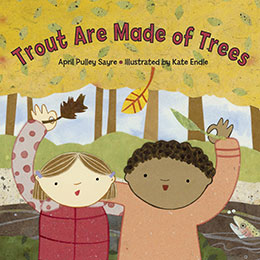 Trout are Made of Trees (Charlesbridge, 2008), illustrated by Kate Endle, is just one of the many connections she wrote about that inspire curiosity and delight. “In fall trees let go of leaves that swirl and twirl and slip into streams,” the book begins. “They ride in the rush above rocks and over rapids. They sag and settle soggily down.” The energy of alliteration, the quick snap zap of rhymes, the rhythm of her sentences take readers along for on the rushing ride. As the leaves settle into the stream, they are broken down by algae, and the “shredders — caddisflies, stoneflies, caddisflies, shrimp and crane flies.” Unspecified predators eat the shredders who have eaten the leaves and are themselves eaten by trout in swift rhyming action: “Swim and snap. Fins slip. Rush zap.” Finally, people (and bears) who eat the trout become partly made of trees as well — a wondrous interconnection.
Trout are Made of Trees (Charlesbridge, 2008), illustrated by Kate Endle, is just one of the many connections she wrote about that inspire curiosity and delight. “In fall trees let go of leaves that swirl and twirl and slip into streams,” the book begins. “They ride in the rush above rocks and over rapids. They sag and settle soggily down.” The energy of alliteration, the quick snap zap of rhymes, the rhythm of her sentences take readers along for on the rushing ride. As the leaves settle into the stream, they are broken down by algae, and the “shredders — caddisflies, stoneflies, caddisflies, shrimp and crane flies.” Unspecified predators eat the shredders who have eaten the leaves and are themselves eaten by trout in swift rhyming action: “Swim and snap. Fins slip. Rush zap.” Finally, people (and bears) who eat the trout become partly made of trees as well — a wondrous interconnection.
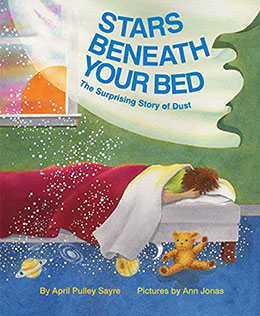
In Stars Beneath Your Bed: The Surprising Story of Dust (Greenwillow, 2005), illustrated by Ann Jonas, Pulley instills something as mundane as dust with wonder. “Dust is little bits of things,” Pulley writes, and in clear engaging language she lists some of the dust’s origins: butterfly scales, a seal’s eyelashes, salt from a breaking ocean wave, the smoke from burning toast, the ash from an erupting volcano. Some dust might be hundreds of years old. “Dust that made King Tut sneeze is still on earth.” Dust might even be from outer space. “Cosmic dust has probably landed on your head without you even knowing it.”
From sunrise to sunset whose colors come from “the dust of our days”) Pulley shows us dust as something wonderful.
Wind spreads dust,
floating,
swirling,
sprinkling,
bits of you and me
and soil
and stars.
Backmatter gives more information about dust, its sources, its impacts, how raindrops need dust to form, how dust can circumnavigate the earth. Who knew dust was so endlessly fascinating? Sayre did, and she shares that wonder with us.
Dig Wait Listen: A Desert Toad’s Tale (Greenwillow, 2001), illustrated by Barbara Bash, takes us
Deep in the desert,
under the sand, [where] the spadefoot
toad waits…for the sound of rain
Skitter skitter scratch. Is it rain?
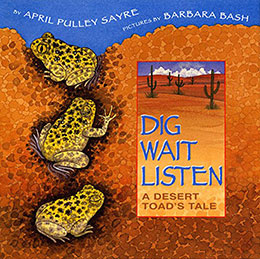 No, only a scorpion crawling overhead. Thunk thunk thunk clink clunk clink clunk pop pop—sound after sound the toad wait. Is it rain? No, it’s a herd of peccaries, a leaping rat, a tapping Gila woodpecker, a park ranger’s boot, a rattlesnake warning STAY AWAY, a distant storm rumbling … until plip plop plip plop. Rain at last.
No, only a scorpion crawling overhead. Thunk thunk thunk clink clunk clink clunk pop pop—sound after sound the toad wait. Is it rain? No, it’s a herd of peccaries, a leaping rat, a tapping Gila woodpecker, a park ranger’s boot, a rattlesnake warning STAY AWAY, a distant storm rumbling … until plip plop plip plop. Rain at last.
Hearing it, the toad digs out of the sand. Now she hears bleat bleat bleat—male toads calling. In a puddle left by the rain the toad lays her eggs “like beads of glass” which hatch in two days and race the drying puddle to develop from tadpoles into toads. The story ends with the new toads, safely metamorphosed, digging down into the sand to wait for — the sound of rain.
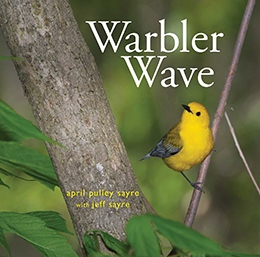 Warbler Wave (Beach Lane Books; 2018) asks us as writers and readers to home in on Sayre’s ear for language. She says of warblers: “Tiny, strong/pushed along/by rivers of wind.” There’s so much here to please the ear — alliteration, assonance, rhyme — all in only seven words. But that’s not all, the book goes on, “They share the air/with buildings/bats, turbines, and towers.” Like all good poetry, when we read it we cannot imagine any other arrangement of words that would work as well. She translates her love of nature into delight in sound that subtly brings readers into the story. If we had lap sitter listeners we would always have Warbler Wave on the story pile because it has such wonderful language: birds she calls “flying flowers” “search, stalk/wag, walk,/ “look, lean, grab, glean” as they try to feed themselves. Sayre calls them “crushers of caterpillars,” “slurpers of spiders.” Who would not want to repeat “slurpers of spiders?”
Warbler Wave (Beach Lane Books; 2018) asks us as writers and readers to home in on Sayre’s ear for language. She says of warblers: “Tiny, strong/pushed along/by rivers of wind.” There’s so much here to please the ear — alliteration, assonance, rhyme — all in only seven words. But that’s not all, the book goes on, “They share the air/with buildings/bats, turbines, and towers.” Like all good poetry, when we read it we cannot imagine any other arrangement of words that would work as well. She translates her love of nature into delight in sound that subtly brings readers into the story. If we had lap sitter listeners we would always have Warbler Wave on the story pile because it has such wonderful language: birds she calls “flying flowers” “search, stalk/wag, walk,/ “look, lean, grab, glean” as they try to feed themselves. Sayre calls them “crushers of caterpillars,” “slurpers of spiders.” Who would not want to repeat “slurpers of spiders?”
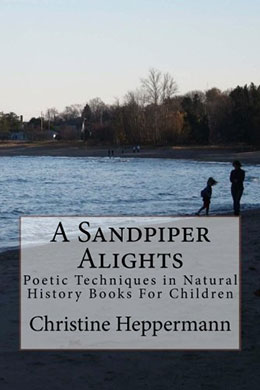 Author and critic Christine Hepperman has described Sayre as a poet who happens to write natural history. In A Sandpiper Alights Hepperman writes, “April Pulley Sayre excels at showing children the world through a field biologist’s eyes.” Sayre actually studied biology and anthropology, but when she went to Madagascar to study its rain forests she found she loved writing about them even more. Her eye for the small details of the natural world and her ability to convey them through her writing enchant children and adults alike.
Author and critic Christine Hepperman has described Sayre as a poet who happens to write natural history. In A Sandpiper Alights Hepperman writes, “April Pulley Sayre excels at showing children the world through a field biologist’s eyes.” Sayre actually studied biology and anthropology, but when she went to Madagascar to study its rain forests she found she loved writing about them even more. Her eye for the small details of the natural world and her ability to convey them through her writing enchant children and adults alike.
Who knows what other wonders she might have shared with us had she had more time? Most of all she taught us to look closely, to listen, to learn about the world we inhabit and in which we are all connected.
And isn’t that a wonder?
A few more of our favorites by April Pulley Sayre:
If You Should Hear a Honey Guide (illustrated by S.D. Schindler, Houghton Mifflin, 2000)
Vulture View (illustrated by Steve Jenkins, Henry Holt, 2007)
Woodpecker Wham (illustrated by Steve Jenkins, Henry Holt, 2015)
Being Frog (Beach Lane, 2020)
Thank You Earth (Greenwillow, 2021)
Happy Sloth Day (with Jeff Sayre, Beach Lane, 2022)

Everything about this sharing is peaceful, playful & perhaps most important full of Spot-on titles to seek & savor. Appreciations.